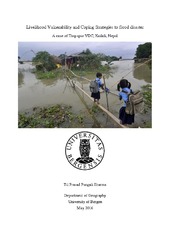Livelihood Vulnerability and Coping Strategies to flood disaster. A case of Thapapur VDC, Kailali, Nepal
Master thesis
Permanent lenke
https://hdl.handle.net/1956/19452Utgivelsesdato
2016-05-19Metadata
Vis full innførselSamlinger
- Department of Geography [676]
Sammendrag
Nepal has been facing different kind of hazards especially water induced disaster in summer season. Many people have been affecting from disaster every year. Flood is a frequent disaster in Tarai region because of intense rainfall within a short period (June to September). Flood disaster mainly affects land- farming activities; on the other hand, many Nepalese rural people are depending on land farming as their major livelihood activities. Therefore, agriculture based human livelihoods highly vulnerable to flood disaster in Nepal. In addition to that, such disaster has a differential impact on human livelihood. The focus of the study is to find condition of livelihood vulnerability and coping strategy to flood disaster from western Nepal. Ninety-nine frequently hazard affected households were interviewed from Thapapur Village Development Committee (VDC) of Kailali district (western Tarai of Nepal) by using purposive sampling method, eight key informant interviews and two group discussions were done from three and half months' fieldwork. Livelihood framework has used to study the condition of livelihood. In addition, concept of Pressure and Release (PAR), and access model have used to analyse household vulnerability. Although there are no human causalities for seven years, the disaster has high impacts on agriculture production especially paddy cultivation, which is the major livelihood activities of the VDC. In addition to that the flood destroys house wall, enter into house and swept food grain are seasonal disaster impact in the VDC. The financial asset of household livelihood is poor in Thapapur VDC and playing negative role in livelihood building process. Diversification on income source and structural changes are major coping strategy observed in the area buts its effectiveness is differ with their economic condition. Household income dependency on agriculture has been reduced and new buildings are built flood resistant (use tall timber). The finding suggests that landholding size is the major determinant household livelihood vulnerability. When I traced back the present unsafe livelihood condition to the root cause, it is found that the main reasons of household vulnerability are improper government resettlement scheme for ex- bounded labourer, population growth and fragmentation of land, and unequal land distribution. Having poor financial asset, the household has fragile self-protection measures. In addition to that, the VDC has poor social protection measure to flood disaster and has weak structure of domination too that lead high disaster loss. Mostly people are using indigenous disaster management activities that are not sufficient to reduce the flood effect on livelihood in future.

